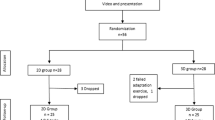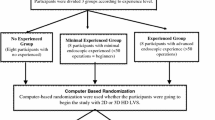Abstract
Background
Simulators are being used to teach laparoscopic skills before residents get to the operating room. It is unknown whether the use of three-dimensional (3D) vision will facilitate laparoscopic training. Therefore, our objective was to compare the effectiveness of using 3D imaging over the traditional two-dimensional (2D) imaging to teach laparoscopic simulator skills to novice individuals and assess whether 3D imaging ameliorates laparoscopic performance for surgeons who have already adapted to working within a 2D surgical environment.
Methods
This prospective study involved 36 surgical residents and students. Inexperienced participants included medical students and first- and second-year surgical residents (n = 25). Experienced participants included third- and fifth-year surgical residents (n = 11). Participants were tested on six laparoscopic skills using 2D or 3D imaging systems and then retested about 3 months later using the opposing imaging system. Evaluation of performance was based on the time elapsed to task completion and the errors committed during that time.
Results
The experienced participants performed better than the inexperienced participants regardless of the imaging system. Inexperienced participants initially tested using 2D imaging required significantly more time and/or made more errors to complete five of the six laparoscopic tasks compared to those initially tested using 3D imaging (p < 0.05). After initial testing on 3D imaging, inexperienced participants retested using 2D imaging performed significantly better on five of six tasks compared to the scores of inexperienced participants initially tested on 2D imaging (p < 0.05). In contrast, the inexperienced participants’ retested on 3D after initial 2D imaging did not improve on any laparoscopic task compared to the scores of inexperienced participants initially tested on 3D imaging. Among the experienced participants, no significant difference in time or errors to task completion was observed under 2D imaging compared to 3D imaging during the first or second testing session.
Conclusions
Our study indicates that 3D imaging offers significant advantages in the teaching of laparoscopic skills to inexperienced individuals.



Similar content being viewed by others
References
Taffinder N, Smith SG, Huber J, et al. (1999) The effect of a second-generation 3D endoscope on the laparoscopic precision of novices and experienced surgeons. Surg Endosc 13:1087–1092
Perkins N, Starkes JL, Lee TD, et al. (2002) Learning to use minimal access surgical instruments and 2-dimensional remote visual feedback: how difficult is the task for novices? Adv Health Sci Educ 7:117–131
Risucci D, Geiss A, Gellman L, et al. (2001) Surgeon-specific factors in the acquisition of laparoscopic surgical skills. Am J Surg 181:289–293
Windsor JA, Zoha F (2005) The laparoscopic performance of novice surgical trainees: testing for acquisition, loss, and reacquisition of psychomotor skills. Surg Endosc 19:1058–1063
Chan AC, Chung SC, Yim AP, et al. (1997) Comparison of two dimensional vs. three dimensional camera systems in laparoscopic surgery. Surg Endosc 11:438–440
Thomsen MN, Lang RD (2004) An experimental comparison of 3-dimensional and 2-dimensional endoscopic systems in a model. Arthroscopy 20:419–423
McDougall EM, Soble JJ, Wolf JS Jr, et al. (1996) Comparison of three-dimensional and two-dimensional laparoscopic video systems. J Endourol 10:371–374
Jones DB, Brewer JD, Soper NJ (1996) The influence of three-dimensional video systems on laparoscopic task performance. Surg Laparosc Endosc 6:191–197
Peitgen K, Walz MV, Walz MV, et al. (1996) A prospective randomized experimental evaluation of three dimensional imaging in laparoscopy. Gastrointest Endosc 44:262–267
Hanna GB, Cuschieri A (2000) Influence of two-dimensional and three-dimensional imaging on endoscopic bowel suturing. World J Surg 24:444–449
Bhayani SB, Andriole GL (2005) Three-dimensional (3D) vision: does it improve laparoscopic skills? An assessment of 3D head-mounted visualization system. Rev Urol 7:211–214
Sun CC, Chiu AW, Chen KK, et al. (2000) Assessment of a three dimensional operating system with skill tests in a pelvic trainer. Urol Int 64:154–158
Byrn JC, Schluender S, Divino CM, et al. (2007) Three dimensional imaging improves surgical performance for both novice and experienced operators using the da Vinci Robot System. Am J Surg 193:519–522
Powers TW, Bentrem DJ, Nagle AP, et al. (2005) Hand dominance and performance in a laparoscopic skills curriculum. Surg Endosc 19:673–677
Grantcharov TP, Bardram L, Funch-Jensen P, et al. (2003) Impact of hand dominance, gender and experience with computer games on performance in virtual reality laparoscopy. Surg Endosc 17:1082–1085
Reed JF (2004) Analysis of two treatment, two period cross trials in emergency medicine. Ann Emerg Med 43:54–58
Grantcharov TP, Bardram L, Funch-Jensen P, et al. (2003) Learning curves and impact of previous operative experience on performance on virtual reality simulator to test laparoscopic surgical skills. Am J Surg 185:146–149
Everbusch A, Grantcharov TP (2004) Learning curves and impact of psychomotor training on performance in simulated colonoscopy: a randomized trial using a virtual reality endoscopy trainer. Surg Endosc 18:1514–1518
Fraser SA, Freldman LS, Stanbridge D, et al. (2005) Characterizing the learning curve for a basic laparoscopic drill. Surg Endosc 19:1572–1578
Torkington J, Smith SG, Rees B, et al. (1001) The role of the basic surgical skills course in the acquisition and retention of laparoscopic skills. Surg Endosc 15:1071–1075
Hanna GB, Shimi SM, Cuschieri A (1998) Randomized study of the influence of two dimensional versus three dimensional imaging on performance of laparoscopic cholecystectomy. Lancet 351:248–251
Acknowledgment
We thank Viking Systems (La Jolla, CA, USA) for allowing us to use their 3Di Digital Visual System for this study.
Author information
Authors and Affiliations
Corresponding author
Rights and permissions
About this article
Cite this article
Votanopoulos, K., Brunicardi, F.C., Thornby, J. et al. Impact of Three-Dimensional Vision in Laparoscopic Training. World J Surg 32, 110–118 (2008). https://doi.org/10.1007/s00268-007-9253-6
Published:
Issue Date:
DOI: https://doi.org/10.1007/s00268-007-9253-6




